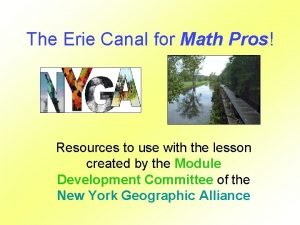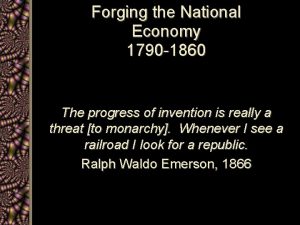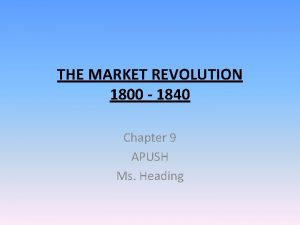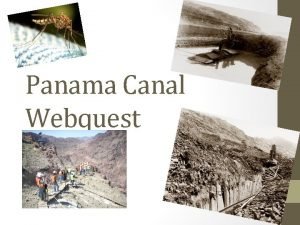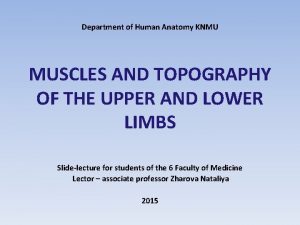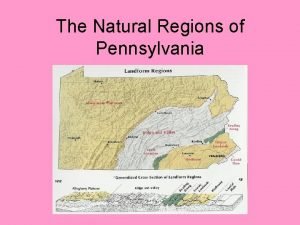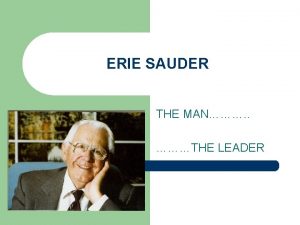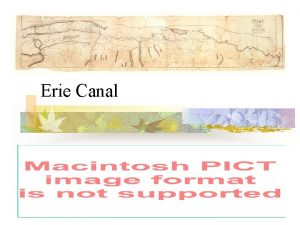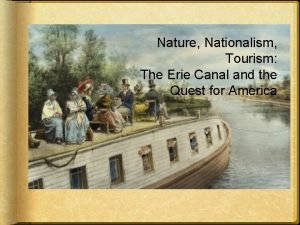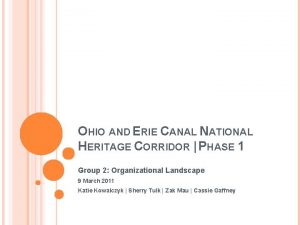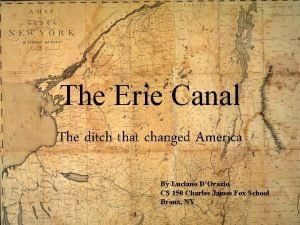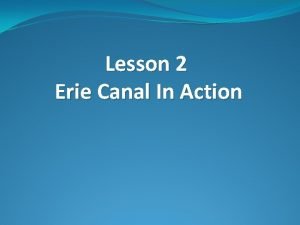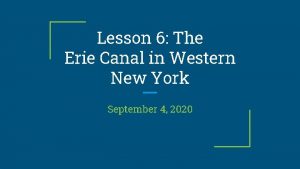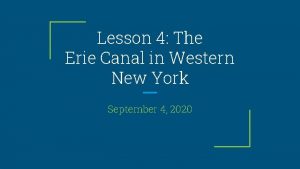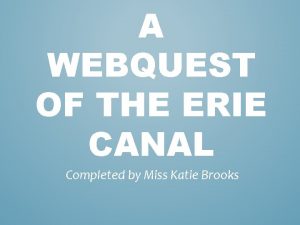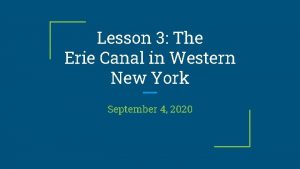An Economic Journey through the Erie Canal AIM




















- Slides: 20

An Economic Journey through the Erie Canal AIM: What were the effects of the Erie Canal? Do Now: What is New York State’s Nickname?

What is a canal? • The word canal comes from the Latin canalis meaning pipe or channel. • A canal is a man made, artificial body of water or channel - that provides movement from one body of water to another body while holding the water almost motionless so that boats can move in both directions.

How can a canal shape a nation’s economy? • By allowing boats to move in both directions, a canal provides a way to move goods and services quickly and inexpensively from one place to another. • The Erie Canal did just that - it allowed goods and services to flow 363 miles eastward from Buffalo, on Lake Erie in upstate New York, to Albany on the Hudson River and then 150 miles downstream to New York City. It also allowed the eastern flow of goods and services via the reverse route.

While experts disagree about the effect of building the Erie Canal on all Americans, they all agree that it both shaped and stimulated the U. S. economy. • In Wedding of the Waters, Peter Bernstein argues that the Erie Canal stimulated the Industrial Revolution, propelled globalization, and revolutionized the entire world’s food production and supply networks. In so doing, it demonstrated that “trade and commerce are the keys to the expansion of prosperity and freedom itself. ”. • Thus, to Bernstein, the building of the Erie Canal is the story of “how a revolutionary technological network molded the triumph of the U. S. as a continental power and as a giant in the world economy. ”

• Bernstein further argued that the U. S. was in great need of a major • economic stimulus to move goods from east to west and west to east. The transportation system that existed in 1800 “…was not just obsolete it was a positive restraint on economic growth. ” Stimulating the nation’s economic growth became the goal of New York State which financed the Erie Canal by selling its own bonds to the public and financial markets abroad. State financing was a complete success the tolls collected were far in excess of the operating expenses and the state easily repaid its bonds.

• Stanley Engerman and Kenneth Sokoloff go one step further - not • only was the Erie Canal the nation’s first large public works project but New York State accepted the challenge largely because its scope was beyond what a private firm could manage during the early 19 th Century. The construction of the Erie Canal was well conceived and executed by the New York legislature; it paid off more than its costs through tolls and it also generated substantial welfare improvements for New Yorkers in the form of producer and consumer surplus.

In short, the experts agree, the Erie Canal was the transportation marvel and economic model of its day. It reduced the travel time from the Hudson River to the Great Lakes by one half and provided travelers a welcome alternative to the rutted, muddy road of the stage coach. Passengers traveled on packet boats pulled by a team of horses or mules at a leisurely pace equivalent to that of a fast walk.

While experts on the Erie Canal continuously praise such economic progress, some are clear that not all prospered. • In The Artificial River, Carol Sheriff argues that while new commercial endeavors made possible by the Erie Canal certainly meant success or “progress” for a select group of well-invested merchants and developers, the canal also caused irreversible destruction to the way of life and property of many citizens. • She paints a picture of two groups Dewitt Clinton, member of Canal Commission and Canal promoter. wrestling with the idea of the “common good” and with the emerging “culture of progress”: the members of the Canal Board and the residents of the Canal corridor.

Indeed, while most studies of the Erie Canal focus on the story of economic progress and political intrigue, few focus on the laborers who built the Canal. • The 363 -mile Canal was built in eight years for $7. 2 million by somewhere between 8, 000 and 9, 000 laborers, many of whom were Irish immigrants, and with the help of 10, 000 horses and mules. • The first step occurred when the crews moved through the wide Mohawk River Valley, clearing the forests of thousands of trees, chopped them up into movable sizes, uprooted the stumps, then carted away the logs, branches, and leaves.

• The ground was then ready for excavation. But no one • had built anything as enormous as the Erie Canal. In the early stages, the men dug with spades and carted the excess earth away on wheelbarrows. Later, horse-drawn plows carted away the earth, crude pulleys were used to move large objects, and stump pullers were invented. In short, the entire canal was essentially a hand dug ditch that was 4 feet deep and 40 feet wide.

• But the Erie Canal was more than just a long ditch or a man-made river. • Lake Erie was 571 feet higher than the Hudson River and the land from Buffalo at Lake Erie to Albany on the Hudson River is not level. So Canal builders used eighty-three locks to lift and lower boats. A lock is like a big box that opens at both ends. When a boat enters a lock and needs to be lifted, the ends are closed and water is pumped into the box. Once the boat floats to the new higher level, the box is opened and the boat continues on its journey. When a boat is being lowered, water flows out of the box until the boat is at the lower level.

• The canal’s design was too shallow and narrow for steamboats, impractical for sail boats, and too slow and impossible a job for poling due to heavy loads. • The only practical method was towing flat bottomed boats pulled by horses or mules, bringing travel to about four miles per hour. The boats floated in the canal and the horses and mules walked beside the canal on a dirt towpath. Ropes were tied to the boat and to animals. • The canal had to have a towpath along the entire width of the canal which was designed to be 20 feet wider than the 40 foot wide ditch.

The first builders of the Erie Canal faced enormous engineering challenges at a time when there were almost no professional engineers in the United States. The principal engineers were not professionally trained engineers when they began the project. Nevertheless, they were able to construct a canal so successful that it outgrew itself almost immediately.

• Among the obstacles they faced were leveling all 363 miles of the Canal; building bridges for all paths that crossed the canal; constructing aqueducts in order to cross other bodies of water; designing and operating locks and aqueducts; and finding a substance that could seal the spaces between the stones lining the canal, the locks, and aqueducts. • One by one, the men who designed and who built the Canal overcame the obstacles. A local scientist in a small town along the Canal route performed an experiment in a local bar to make a crude cement - and it worked.

• The going wage for labor was $12 a month, or fifty cents • • for each day on the job. The men received ample food and drink, as well as crude sleeping quarters. The work was hard and dangerous.

The Erie Canal was a huge economic success! Indeed, the Canal… • Opened the northwest to new markets and people, • • • thus stimulating a national market economy. Linked the west with the east, thereby changing the primary transportation axis from north to south to east to west. Created canal towns that offered a wide range of economic activities and welcomed business entrepreneurs. Contributed to the pace of technological innovation, especially through the sharp rise of patents along the Canal route. Transformed New York City into the Empire State. Provided a viable model for a successfully financed and operated public works project.

Transportation and Communication Businesses needed ways to transport raw materials to their growing number of factories and mills and to ship their finished goods to market. Roads In 1811 construction began on the National Road. • It was completed in 1841. • Stretched 800 miles west from Cumberland, Maryland, to Vandalia, Illinois • Most roads were much shorter and crudely made. • By 1840 a network of roads connected most of the cities and towns throughout the United States, promoting travel and trade.

Transportation and Communication Canals • In 1825 the 363 -mile-long Erie Canal opened, connecting the Great Lakes with the Hudson River—and with the Atlantic Ocean. • The canal provided a quick and economical way to ship manufactured goods to the West and farm products to the East. • Within 15 years after the success of the Erie Canal, more than 3, 000 miles of canals formed a dense network in the northeast.

Transportation and Communication The steamboat • The first successful steamboat service was run by Robert Fulton on the Hudson River with his boat, the Clermont. • Within a decade, dozens of steamboats were puffing up and down the Ohio, the Mississippi, and other rivers. The railroad • The first steam-powered train ran in the United States and made its first trip in 1830. • By 1840 there were about 3, 000 miles of track in the country. • The speed, power, reliability, and carrying capacity of the railroad quickly made it a preferred means of travel and transport.

Transportation and Communication Printing press • Steam-powered presses enabled publishers to print material much faster and in much greater volume than ever before. Postal service • With the growing use of steamboats and the railroad, mail delivery was faster and more widely available. The telegraph • Considered the greatest advancement in communication • Samuel F. B. Morse patented the first practical telegraph in 1840. • Communication by telegraph was instantaneous. • Newspapers, railroads, and other businesses were quick to grasp its advantages. http: //www. mysocialstudiesteacher. com/morse/
 The lake erie canal ielts reading answers
The lake erie canal ielts reading answers What was the goal of the erie canal?
What was the goal of the erie canal? Eureka math pros and cons
Eureka math pros and cons Map of the erie canal
Map of the erie canal Isaac singer apush
Isaac singer apush Explain the roosevelt corollary
Explain the roosevelt corollary Formula de blasius
Formula de blasius Indicate nerve passing through cruropopliteal canal:
Indicate nerve passing through cruropopliteal canal: Rci erie pa
Rci erie pa Alerting erie
Alerting erie Erie county department of mental health
Erie county department of mental health Are lake erie water snakes poisonous
Are lake erie water snakes poisonous Lake erie coastal plain
Lake erie coastal plain Erie times news circulation
Erie times news circulation Erie ontario lowlands age of bedrock
Erie ontario lowlands age of bedrock Erie railroad v stewart
Erie railroad v stewart Sand dunes lake erie
Sand dunes lake erie Autoclave engineers erie pa
Autoclave engineers erie pa Sauder family
Sauder family Erie lowland
Erie lowland Journey of a cheese sandwich through the digestive system
Journey of a cheese sandwich through the digestive system


